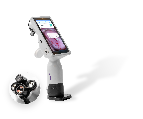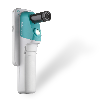Presented at the 2020 ASCCP Annual Scientific Sessions
AT Goldstein (1), S Bedell (1), R Lipson (2), CM Sebag (3), L Lobel (3), D Levitz (3)
(1) 1 Center for Vulvovaginal Disorders, Washington, DC, USA (2) United Family Healthcare Hospitals, Beijing, China (3) MobileODT, Tel Aviv, Israel
Objective: The goal of this study is to determine whether a preliminary version of AVE can be used at the point of care (PoC) in LRS, and how it integrates into the clinical workflow. Here, AVE was used to assess patients in a screening camp in Inner Mongolia, China.
Methods: An existing AVE classifier was integrated into the EVA System as web service. The classifier was deployed on the cloud and is called by the provider from the patient records on the EVA image portal.
The EVA System was used for imaging HPV+ patients, as part of the care provided in a screening camp in Inner Mongolia, China. Suspect regions on the cervix were biopsied and analyzed in United Family Healthcare Hospitals in Beijing. AVE scores were compared to histopathology results. Positives were defined by CIN 2+ histopathology.
A secondary analysis also assessed test reliability at the PoC. Test inadequacy rates were measured against colposcopic impression.
Results: A Receiver Operating Characteristic curve was calculated on AVE scores, showing AVE to be more sensitive than specific on HPV+ patients from the screening camp.
Conclusions: The tested implementation of AVE – uploading images to the patient file and running the classifier immediately – proved feasible for use in low resource settings.
The inadequacy rate of AVE – cases that did not sync – was very low (1.3%), and smaller than the rate at which colposcopic impression was not feasible.
In comparison to data from other studies on triage of HPV+ patients, the performance of AVE compared favorably to that of existing and emerging triage methods including cytology, dual p16/Ki67 stain, and DNA methylation.







